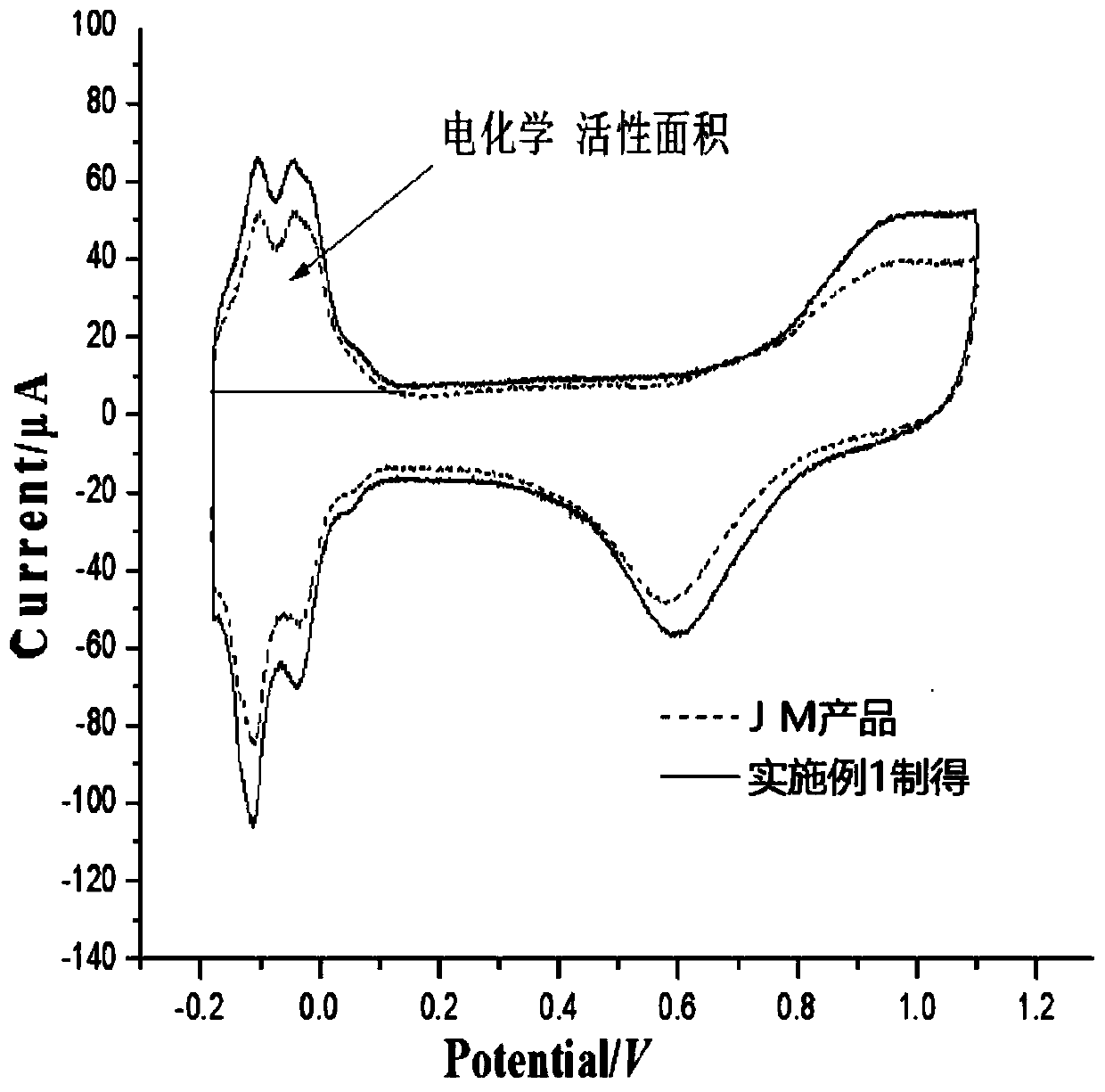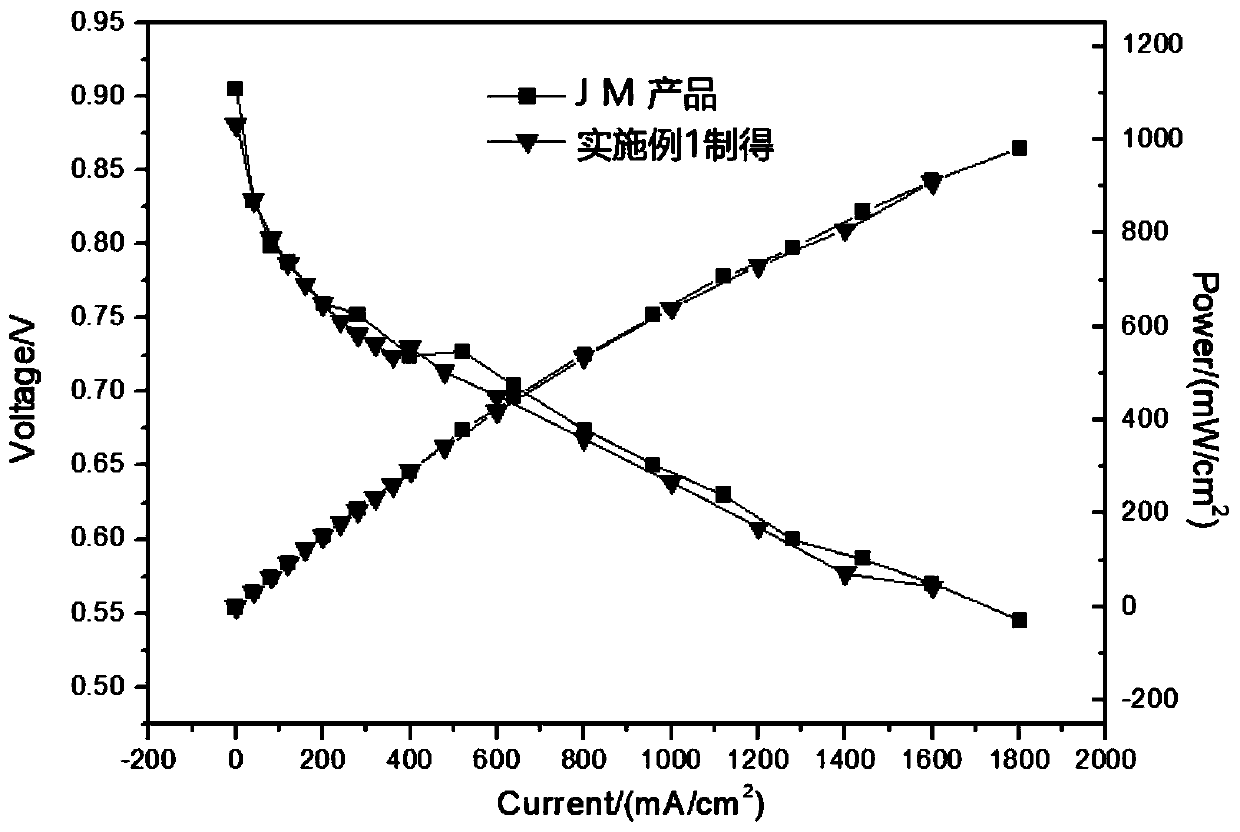Preparation method of fuel cell catalyst
A fuel cell and catalyst technology, applied in battery electrodes, circuits, electrical components, etc., can solve the problems of reducing the amount of Pt used, and achieve the effects of uniform catalyst, saving reaction time, and good bulk density
- Summary
- Abstract
- Description
- Claims
- Application Information
AI Technical Summary
Problems solved by technology
Method used
Image
Examples
Embodiment 1
[0026] A preparation method of fuel cell catalyst, carried out according to the following steps:
[0027] Ⅰ The amount of carbon carrier is calculated based on 3g of carbon carrier contained in 1L of ethylene glycol and deionized water mixture. The carbon carrier uses Vulcan XC-72 carbon black, and the amount of platinum source is based on the mixture of 1L of ethylene glycol and deionized water. The solution contains 2g of platinum element. The platinum source is ethylene glycol solution of chloroplatinic acid hexahydrate. The volume ratio of ethylene glycol and deionized water in the mixture of ethylene glycol and deionized water is 1:1. Add the carbon carrier to the mixture of ethylene glycol and deionized water for ultrasonic dispersion for 30 minutes, then add the platinum source to the mixture of ethylene glycol and deionized water in which the carbon carrier has been dispersed, and stir for 30 minutes to form a mixed slurry. Add the ethylene glycol solution of potassium...
Embodiment 2
[0035] A method for preparing a fuel cell catalyst, the steps of which are basically the same as those of the method for preparing a fuel cell catalyst in Example 1, except that:
[0036] 1. In step Ⅰ, the amount of carbon carrier is calculated based on 2g of carbon carrier contained in 1L of ethylene glycol and deionized water mixture. The carbon carrier is Ketjen Black ECP600JD. The water mixture contains 3g of platinum element, the platinum source is platinum acetylacetonate solution, the volume ratio of ethylene glycol to deionized water in the mixture of ethylene glycol and deionized water is 1:0.5, and the carbon carrier The ultrasonic dispersion time is controlled to 60 minutes, the stirring time of the platinum source is controlled to 40 minutes, the pH value of the mixed slurry is controlled to 9, and when the pH of the mixed slurry is adjusted to 9, continue to stir for 40 minutes;
[0037] 2. In step II, the time for feeding nitrogen into the mixed slurry is control...
Embodiment 3
[0041] A method for preparing a fuel cell catalyst, the steps of which are basically the same as those of the method for preparing a fuel cell catalyst in Example 1, except that:
[0042] 1. In step Ⅰ, the amount of carbon carrier is calculated based on 4g of carbon carrier contained in 1L of ethylene glycol and deionized water mixture. The carbon carrier is carbon black (Ketjen Black ECP600JD), and the amount of platinum source is based on 1L The mixed solution of alcohol and deionized water contains 1g of platinum element calculation, the platinum source is sodium chloroplatinate hexahydrate solution, and the volume ratio of ethylene glycol and deionized water in the mixed solution of ethylene glycol and deionized water is 1:1.5, the ultrasonic dispersion time of the carbon carrier is controlled to 90 minutes, the stirring time of the platinum source is controlled to 60 minutes, the pH value of the mixed slurry is controlled to 11, and when the pH of the mixed slurry is adjus...
PUM
 Login to View More
Login to View More Abstract
Description
Claims
Application Information
 Login to View More
Login to View More - R&D
- Intellectual Property
- Life Sciences
- Materials
- Tech Scout
- Unparalleled Data Quality
- Higher Quality Content
- 60% Fewer Hallucinations
Browse by: Latest US Patents, China's latest patents, Technical Efficacy Thesaurus, Application Domain, Technology Topic, Popular Technical Reports.
© 2025 PatSnap. All rights reserved.Legal|Privacy policy|Modern Slavery Act Transparency Statement|Sitemap|About US| Contact US: help@patsnap.com


